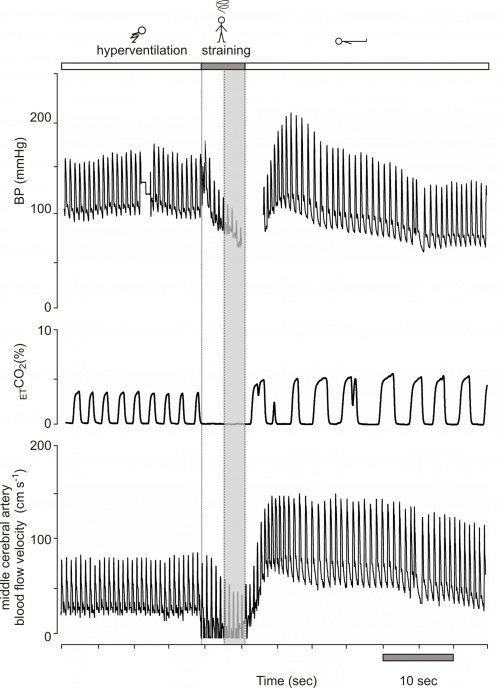Self-induced syncope: the fainting lark
W. Wieling, J.J. van Lieshout.
Department of Medicine. Academic Medical Centre. University of Amsterdam. Amsterdam (The Netherlands).
The fainting lark is a self-applied manoeuvre that induces fainting [1]. Self-induced fainting has been used by children, high school students and military recruits as entertainment for their friends [2-4]. The fainting lark has also been applied as a research tool to document the sequence of events during abrupt onset syncope in young subjects [4].
The classical procedure consists of squatting in a full knee bend and overbreathing by taking about 20 deep breaths. The subject then stands up suddenly and performs a forced expiration against a closed glottis.
The figure documents the precipitous and deep fall in arterial pressure and cerebral blood flow in one of the authors (WW) [1]. The subject briefly (2-3 s) lost consciousness preceded by an extreme short period of light-headedness and black out. Note the overshoot in blood pressure after lying down. .
Editor's comments
The fainting lark combines the effects of systemic arterial hypotension induced by acute vasodilatation of the lower limbs (the combination of standing up and the post-ischemic effect of squatting) and decreased cardiac output (effects of arising and raised intrathoracic pressure) and cerebral vasoconstriction induced by hypocapnia (due to hyperventilation) [2]. The high cerebral venous pressure induced by straining can be expected to play an important adjunctive role in the effectiveness of the fainting lark to induce fainting [6]. The fainting lark can trigger syncope in almost anyone. Myoclonic jerks directly after falling down are observed in the majority of the subjects engaged [2,5].
Other manoeuvres that are applied to induce syncope are the mess trick [2] recently described as suffocation roulette [7]. During the latter trick subjects are instructed to take a deep breath and a companion grasps the subject unexpectedly from behind around the chest and squeezes it as hard as he can. The subject automatically closes his glottis, the intrathoracic pressure is raised and the subject faints. This is liable be done as entertainment, usually with the effects of alcohol added to the mechanical effects. Self-induced fainting is reported to be safe, but injuries may occur by falling. Moreover, severe complications and even death have been described [8-10].
References
<biblio>
- Wieling pmid=15310717
<biblio>
